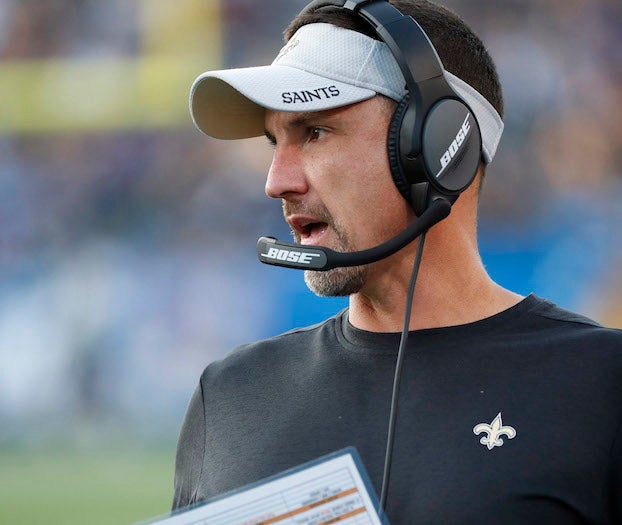New commissioners thrust into conference realignment chaos
Published 7:58 pm Friday, July 23, 2021
By RALPH D. RUSSO
AP College Football Writer
INDIANAPOLIS (AP) — Conference realignment is back on the table in college sports just as three Power Five conferences are breaking in relatively new commissioners.
While the Big 12 is trying to keep Oklahoma and Texas from being poached by the Southeastern Conference, the Big Ten, Pac-12 and Atlantic Coast Conference could be challenged to respond should veteran SEC Commissioner Greg Sankey make a bold move.
Texas and Oklahoma will reportedly inform the Big 12 in the next few days that they are leaving, though neither school has issued any statements beyond non-denial references to rumors.
A 16-team SEC with the Longhorns and Sooners has the potential to make what is already the strongest conference in college football even more dominant and wealthy.
Do the other conferences have to react?
For now, the Big Ten — the SEC’s closest rival in quality and revenue generation —- apparently is not feeling pressured into it.
“We haven’t had conversations (about expansion), we’re not overreacting, it’s not who we are,” Ohio State athletic director Gene Smith said at Big Ten media days Friday. “We just have to pause, study, learn, do what’s right for us. But we haven’t had conversations about that move collectively.”
Smith stressed that having a commissioner in Kevin Warren, who is still settling into college sports after a long career in the NFL, is not an issue for the league.
“What’s a blessing for our league is the collective intellectual knowledge among our ADs and our presidents,” Smith said. “If we decide we need to something we’ll be in good position to do so.”
Warren has been the commissioner since January 2020, but navigating the pandemic has consumed most of his time in the conference. He is still building relationships within his own league.
In the ACC, former Northwestern AD Jim Phillips is in his seventh month as commissioner. Phillips is a veteran of college sports who has been active at the NCAA level. His longevity should give him credibility and relationships across the country.
Phillips already has an expansion target: Notre Dame. The Fighting Irish compete in the ACC in most sports but returned to football independence after a temporary, pandemic-induced season playing in the conference last season.
“That was a really beautiful and beneficial relationship to both Notre Dame and the ACC. They had a chance to play a fantastic schedule,” Phillips said this week. “They had a chance to vie for a national championship and compete in the CFP. We have a real-life example of what that could look like.”
Notre Dame, however, is unfazed by the latest potential upheaval.
“We like our position regardless of how that plays out (with Texas and Oklahoma),” athletic director Jack Swarbrick said.
Years ago, Notre Dame was courted by the Big Ten and passed. Its current deal with the ACC assures the Fighting Irish four or five football games per season with ACC members, but still allows them to be independent and, among other things, able to strike their own TV deals.
The agreement with Notre Dame and the ACC runs through 2036, concurrently with the conference’s TV contract and grant or rights that binds its full members; it says that if Notre Dame were to join a conference it would be the ACC.
Of course, as conference realignment past and present has shown, everything is negotiable.
If Texas and Oklahoma are off the board and heading to the SEC, the only school that could move the needle financially and competitively for another conference to add would be Notre Dame.
In the Pac-12, George Kliavkoff, a former MGM executive, took over officially July 1, though he got a head start in June by attending College Football Playoff meetings on potential expansion of the postseason system.
Realignment has kicked CFP expansion from four to 12 teams to the back burner in college football for now.
Kliavkoff declined to speculate on how an expanded SEC might influence the Pac-12.
“I consider the Pac-12 an exclusive club with high barriers to entry,” Kliavkoff said. “We’re not actively trying to poach teams from other conferences, but we are open to listen if schools reach out to us.”
Geography limits the Pac-12’s possibilities if it did want to expand and a weakened Big 12 is not well positioned to lure Pac-12 schools away from a relatively stable situation.
The Pac-12’s TV deal expires in 2024. The Big 12’s runs through 2025. The Big Ten’s latest deal is done after in 2023.
If the Big 12 wants to save itself by adding, it already has stacks of resumes it can refer back to.
Just five years ago, the conference held something of a casting call and explored expansion. Much of the American Athletic Conference applied, along with schools such as Boise State and BYU.
AAC Commissioner Mike Aresco did not return a message Friday, but a person with knowledge of the conference’s strategy told AP it is working on plans to be proactive and possibly add teams from the Big 12 instead of being poached. The person spoke on condition of anonymity because the league’s internal discussions are private.
———
Follow Ralph D. Russo at https://twitter.com/ralphDrussoAP and listen at https://APpodcasts.com
———
More AP college football: https://apnews.com/hub/college-football and https://twitter.com/AP—Top25





